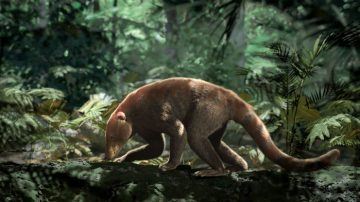Elizabeth Pennisi in Science:
 In 2014, when Ian Miller and Tyler Lyson first visited Corral Bluffs, a fossil site 100 kilometers south of the Denver Museum of Nature & Science where they work, Lyson was not impressed by the few vertebrate fossils he saw. But on a return trip later that year, he split open small boulders called concretions—and found dozens of skulls. Now, he, Miller, and their colleagues have combined the site’s trove of plant and animal fossils with a detailed chronology of the rock layers to tell a momentous story: how life recovered from the asteroid impact that killed off the dinosaurs 66 million years ago.
In 2014, when Ian Miller and Tyler Lyson first visited Corral Bluffs, a fossil site 100 kilometers south of the Denver Museum of Nature & Science where they work, Lyson was not impressed by the few vertebrate fossils he saw. But on a return trip later that year, he split open small boulders called concretions—and found dozens of skulls. Now, he, Miller, and their colleagues have combined the site’s trove of plant and animal fossils with a detailed chronology of the rock layers to tell a momentous story: how life recovered from the asteroid impact that killed off the dinosaurs 66 million years ago.
Plants and animals came back much faster than thought, with plants spurring mammals to diversify, the team reports today in Science. “They get almost the whole picture, which is quite exciting,” says functional anatomist Amy Chew of Brown University. “This high-resolution integrated record really tells us what’s going on.” When the asteroid slammed into Earth, it wiped out 75% of living species, including any mammal much larger than a rat. Half the plant species died out. With the great dinosaurs gone, mammals expanded, and the new study traces that process in exquisite detail. Most fossil sites from after the impact have gaps, but sediment accumulated nearly continuously for 1 million years on the flood plain that is now the Corral Bluffs site. So the site preserves a full record of ancient life and the environment.
Such sites can be hard to date. But Miller, a paleobotanist, and his colleagues collected 37,000 grains of pollen and spores, which revealed a clear marker of the asteroid impact: a surge in the growth of ferns, which thrive in disturbed environments.
More here.
